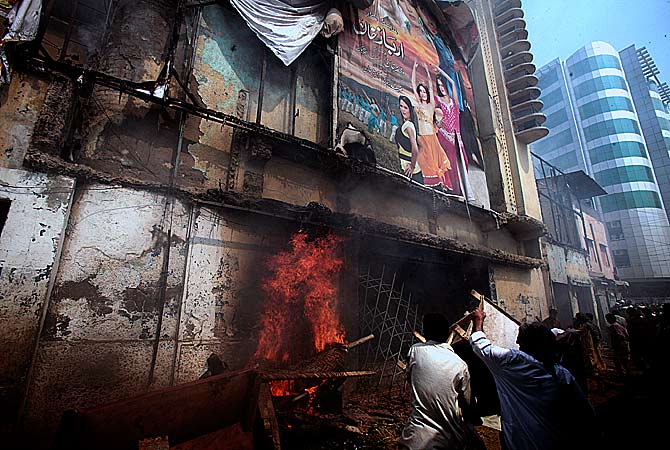Pakistani Cinema Targeted By Militants Opens For Eid
Protesters torch a cinema in Peshawar

NEW DELHI: Shama cinema in Peshawar, attacked by militants with grenades last year, has reopened its doors and will be screening Pashto movies on Ei-dul Fitr. The attack in February last year killed 14 people and injured dozens of others.
The incident was a reminder that Pakistan’s film industry was not free from danger. Many had hoped that the industry was set for a revival after a spate of Taliban-led attacks on cinemas and movie halls in 2009, with 2010 being the lowest point of the industry during which only seven movies were produced, six of which were major “flops.”
Last year, Pakistan’s Zinda Bhaag was chosen as the country’s first entry in 50 years in the foreign film category at the Oscars’, reflecting the growing confidence of an industry that has only produced only a few films in the last few years. 2013 however, has been marked by many as the year of Pakistani cinema.
The stage for revival was set in 2012 when Sharmeen Obaid Chenoy’s Saving Face, about victims of acid attacks in Pakistan, won Pakistan its first Academy Award in the short documentary category. Talk of “revival” and “resurgence” is a throwback to the flourishing film industry of the 1960s and 70s, with films like Bombay-wallah, Shaheed, Armaan, Umrao Jaan Ada and Aina being oft-mentioned. The decline of the industry was set in the 1980s, as General Zia ul-Haq’s regime’s censorship of films saw a decrease in the number of movies being produced in “Lollywood,” the informal name for Pakistan’s Lahore based film industry.
While many blame competition from the Indian film industry as one of the reasons for the decline, Indian films may have had an essential role to play in this recent “revival” and “resurgence.” As the ban on Indian films was relaxed in 2006, the newly available Bollywood productions drew such an overwhelming response from the Pakistani audience that cinema halls proliferated to meet the demand. This has created a film culture in Pakistan, leading to an audience that is not just more receptive to but is demanding an indigenous film indusry.
2013 was witness to the release of 20 Pakistani films and Zinda Bhaag is a befitting choice to represent Pakistani cinema at the international stage; it is a film that plays a tribute to Lahore and 1970s Lollywood. There is an Indian connection to the film, with post production being completed in India. Zinda Bhaag follows other indigenous successes, such as Waar which is the highest grossing Pakistani film till date, and deals with the controversial subject of militancy and terrorism.
Bol was another recent film that did well, becoming the first Pakistani film to do $1m in business at the box office. Like most of the other films being produced in Pakistan in the last two years, Bol deals with sensitive subject matter - that of a zealously religious father who murders his only son, a member of Pakistan’s transgender community.
Film is a powerful insight into the social-cultural fabric of its times. But whether the resurgence of Pakistan’s film industry complemented by the willingness of the audience to engage with controversial subjects such as militancy (in Waar), religious tolerance (Mein Hoon Shahid Afridi), social justice (Josh and Lamha), articulate the mood of a society that is ready to begin the journey toward transition, it may be too soon to say, especially given the violent attacks against any measure of liberal change.



